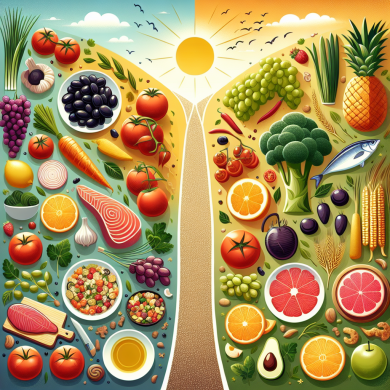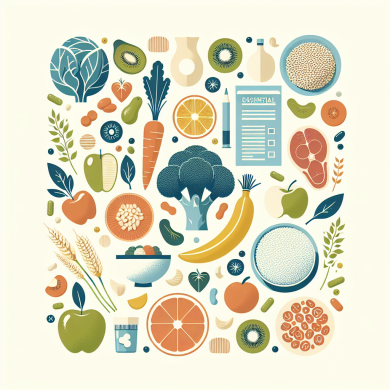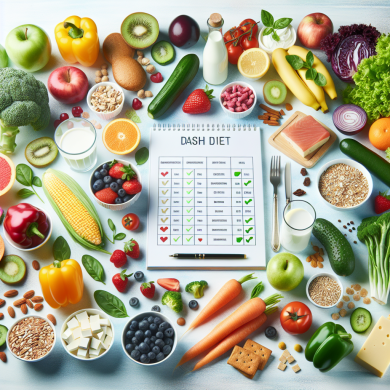Family-Friendly DASH Diet Meal Plan Guide
Introduction to the DASH Diet
The Dietary Approaches to Stop Hypertension (DASH) diet is a scientifically-backed eating plan designed to help reduce blood pressure and promote heart health. It emphasizes the consumption of nutrient-rich foods that are low in sodium, saturated fats, and sugars. The DASH diet is not just beneficial for individuals with hypertension; it is also a versatile and family-friendly approach to healthy eating that can be adapted to suit the needs of all family members, regardless of age.
Understanding the Principles of the DASH Diet
The DASH diet focuses on increasing the intake of fruits, vegetables, whole grains, lean proteins, and low-fat dairy products while reducing the consumption of red meats, sweets, and high sodium foods. Here are the core principles:
1. Emphasize Fruits and Vegetables
Aim for at least 4-5 servings of fruits and 4-5 servings of vegetables per day. These foods are rich in essential vitamins, minerals, and fiber.
2. Opt for Whole Grains
Whole grains like oatmeal, brown rice, and whole wheat pasta provide more nutrients and fiber than their refined counterparts.
3. Choose Lean Proteins
Incorporate lean meats, poultry, fish, beans, and nuts, which are excellent sources of protein without the excess saturated fat found in red meats.
4. Limit Sodium Intake
Keep sodium consumption under 2300 mg per day, and ideally, aim for 1500 mg per day. This involves reading labels carefully and choosing fresh or minimally processed foods.
5. Include Low-Fat Dairy
Consume 2-3 servings of low-fat or non-fat dairy products daily, which provide calcium, vitamin D, and protein.
6. Reduce Saturated Fats and Sugars
Limit foods high in saturated fats and added sugars, such as fatty meats, full-fat dairy, sweets, and sugary beverages.
Creating a Family-Friendly DASH Diet Meal Plan
Designing a meal plan that the whole family can enjoy requires creativity and an understanding of everyone’s dietary preferences. Here’s a guide to help you develop a balanced DASH diet meal plan that caters to both adults and children:
Breakfast Ideas
– **Whole Grain Pancakes with Fresh Berries**: Use whole wheat flour for pancakes and serve with a variety of berries for a nutrient-rich start to the day.
– **Greek Yogurt Parfait**: Layer low-fat Greek yogurt with granola and mixed fruits. This meal is rich in protein, calcium, and fiber.
– **Oatmeal with Nuts and Banana**: Cook oats in low-fat milk and top with sliced bananas and a sprinkle of nuts for added texture and nutrition.
Lunch Options
– **Turkey and Avocado Wraps**: Use whole grain tortillas and fill them with lean turkey slices, avocado, spinach, and a dash of mustard.
– **Quinoa Salad with Chickpeas**: Prepare a salad with cooked quinoa, chickpeas, cherry tomatoes, cucumbers, and a light vinaigrette.
– **Vegetable Soup with Whole Grain Bread**: Make a hearty soup using various vegetables and serve with a slice of whole grain bread.
Dinner Recipes
– **Baked Salmon with Asparagus**: Season salmon fillets with lemon and herbs, bake until tender, and serve with roasted asparagus.
– **Chicken Stir-Fry with Brown Rice**: Stir-fry chicken breast strips with broccoli, bell peppers, and carrots, and serve over brown rice.
– **Vegetable and Bean Chili**: Cook kidney beans, black beans, tomatoes, and a mix of vegetables for a satisfying chili dish.
Snacks and Desserts
– **Apple Slices with Almond Butter**: A simple yet delicious snack that combines fiber and healthy fats.
– **Carrot and Celery Sticks with Hummus**: A crunchy, savory snack that is both filling and nutritious.
– **Frozen Yogurt with Berries**: Blend low-fat yogurt with berries and freeze for a refreshing dessert.
Tips for Implementing the DASH Diet as a Family
Incorporating the DASH diet into your family’s routine might require some adjustments, but these tips can facilitate the transition:
1. Involve Children in Meal Preparation
Encourage children to participate in meal planning and preparation. It can be a fun activity and helps them learn about healthy eating.
2. Gradually Reduce Sodium
If your family is used to higher sodium levels, gradually reduce it by using herbs and spices for flavoring instead of salt.
3. Make Healthy Swaps
Replace white bread with whole grain options, sugary cereals with oatmeal, and sodas with water or herbal teas.
4. Plan Meals Together
Involve all family members in creating the weekly meal plan to ensure everyone’s preferences are considered.
5. Be a Role Model
Children often mimic adults’ eating habits. Set a positive example by following the DASH diet principles yourself.
Overcoming Challenges
Transitioning to the DASH diet may come with challenges, such as resistance from family members or difficulty finding suitable ingredients. Here’s how to overcome these obstacles:
1. Address Picky Eating
Introduce new foods slowly and pair them with familiar favorites. Use creative presentations to make meals appealing to children.
2. Budget-Friendly Shopping
Plan meals around seasonal produce and buy in bulk when possible. Choose store brands for a more economical option.
3. Time Management
Prepare meals in advance, use a slow cooker for easy dinners, and keep healthy snacks readily available to save time.
Conclusion
The DASH diet is a versatile and sustainable approach to healthy eating that can benefit the entire family. By emphasizing whole, nutrient-rich foods and reducing sodium and unhealthy fats, the DASH diet can improve heart health and overall well-being. With thoughtful planning and a focus on family involvement, incorporating the DASH diet into your household can be a rewarding journey towards a healthier lifestyle.















Add comment